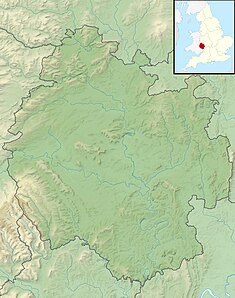History
The estate was established in the late 16th century when the Cocks family purchased land in the area. Subsequent marriages into the Somers and Nash families helped provide the wealth and substance necessary to build the present imposing building, designed to look like one of the medieval castles guarding the Welsh borders.
The castle was built to the designs of Robert Smirke in 1812–20. A.W.N. Pugin made some internal alterations – including the decoration of the Gothic drawing room – in 1849–50, and George E. Fox made further changes in the 1860s. It is constructed of ashlar stonework, with a lead and slate roof concealed behind an embattled parapet. Cast-iron was used for the roof trusses and floor beams. [2] It was constructed at a cost of £85,000, the equivalent of approximately £26 million to £28 million at 2007 prices.
The castle was criticised by Charles Locke Eastlake later in the 19th century:
It is a massive and gloomy-looking building, flanked by watch-towers, and enclosing a keep. To preserve the character at which it aimed, the windows were made exceedingly small and narrow. This must have resulted in much inconvenience within...The building in question might have made a tolerable fort before the invention of gunpowder, but as a residence it was a picturesque mistake.
The castle still has an operating flour mill, "one of the oldest in the county", built in the 18th century as Clencher's. In the 21st century, the water supply was "reinstated and the machinery overhauled so it is now workable". [5] As of 2020, the family occupied only a small part of the castle, "smaller rooms, and we mostly live in the kitchen, which was enlarged in 1992", according to James Hervey-Bathurst, who inherited the property from his mother, [6] the Hon. Mrs Elizabeth Hervey-Bathurst, in 1988. [7]
The castle's business was affected for some time in 2020 due to the COVID-19 pandemic but by mid-July 2020, restrictions were easing. [8] The ironwork bridge over the weir, first installed in 1828, was reopened after restoration in 2021. [9] The castle is open to tours by the public on certain months of the year; it is also a wedding venue. [10]

Augustus Welby Northmore Pugin was an English architect, designer, artist and critic with French and Swiss origins. He is principally remembered for his pioneering role in the Gothic Revival style of architecture. His work culminated in designing the interior of the Palace of Westminster in Westminster, London, and its renowned clock tower, the Elizabeth Tower, which houses the bell known as Big Ben. Pugin designed many churches in England, and some in Ireland and Australia. He was the son of Auguste Pugin, and the father of Edward Welby Pugin, Cuthbert Welby Pugin, and Peter Paul Pugin, who continued his architectural and interior design firm as Pugin & Pugin.
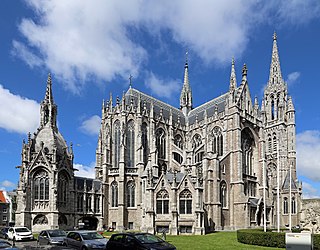
Gothic Revival is an architectural movement that after a gradual build-up beginning in the second half of the 17th century became a widespread movement in the first half of the 19th century, mostly in England. Increasingly serious and learned admirers sought to revive medieval Gothic architecture, intending to complement or even supersede the neoclassical styles prevalent at the time. Gothic Revival draws upon features of medieval examples, including decorative patterns, finials, lancet windows, and hood moulds. By the middle of the 19th century, Gothic Revival had become the pre-eminent architectural style in the Western world, only to begin to fall out of fashion in the 1880s and early 1890s.

Baron Somers, of Evesham in the County of Worcester, is a title that has been created twice. The title was first created in the Peerage of England in 1697 for Sir John Somers, so that he could sit in the House of Lords and serve as Lord Chancellor. The title became extinct on Lord Somers' death in 1716. His sister and co-heiress, Mary Somers, married Charles Cocks, a member of a prominent Worcestershire family. Their grandson Charles Cocks represented Reigate in Parliament from 1747 to 1784, and was created a baronet, of Dumbleton in the County of Gloucester, in the Baronetage of Great Britain in 1772. In 1784 the barony held by his great-uncle was revived when he was made Baron Somers, of Evesham in the County of Worcester, in the Peerage of Great Britain.
The year 1820 in architecture involved some significant events.

Arthur Herbert Tennyson Somers-Cocks, 6th Baron Somers,, was a British Army officer who was the 16th Governor of Victoria, from 1926 to 1931 and Administrator of Australia in 1930-31. He had a long involvement with the Boy Scout Movement and became the Boy Scouts Association's Chief Scout of the British Empire from 1942 until his death.
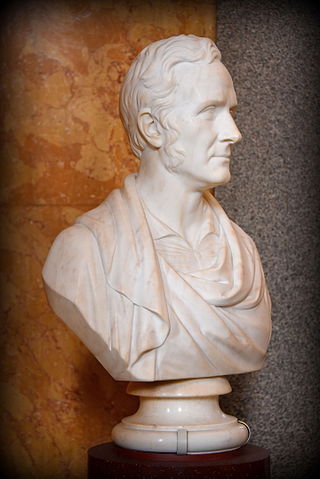
Sir Robert Smirke was an English architect, one of the leaders of Greek Revival architecture, though he also used other architectural styles. As an attached architect within the Office of Works, he designed several major public buildings, including the main block and façade of the British Museum and altered or repaired others. He was a pioneer in the use of structural iron and concrete foundations, and was highly respected for his accuracy and professionalism. His advice was often sought in architectural competitions and urban planning, especially later in his life.

Edward Blore was a 19th-century English landscape and architectural artist, architect and antiquary.

Dumbleton is a village and civil parish in the Tewkesbury district, in the county of Gloucestershire, England. The village is roughly 20 miles from the city of Gloucester. The village is known to have existed in the time of Æthelred I who granted land to Abingdon Abbey, and it is mentioned in the Domesday Book.

Eastnor is a village in Herefordshire, England, 2 mi (3 km) east of Ledbury and the same distance from the tripoint of the county with Worcestershire and Gloucestershire.
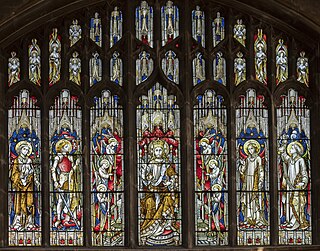
Hardman & Co., otherwise John Hardman Trading Co., Ltd., founded 1838, began manufacturing stained glass in 1844 and became one of the world's leading manufacturers of stained glass and ecclesiastical fittings. The business closed in 2008.

Alton Castle is a Gothic-revival castle, on a hill above the Churnet Valley, in the village of Alton, Staffordshire, England. The site has been fortified in wood since Saxon times, with a stone castle dating from the 12th century. The current castle was constructed in the mid-19th century by John Talbot, 16th Earl of Shrewsbury, of nearby Alton Towers. Since 1967 the castle has been designated a Grade I listed building. It is also a scheduled monument.

Bronsil Castle was a fortified manor house about 1 mile (1.6 km) to the east of Eastnor in Herefordshire, England near Ledbury). It is a Grade II* listed building, first listed in 1967.

Croft Castle is a country house in the village of Croft, Herefordshire, England. Owned by the Croft family since 1085, the castle and estate passed out of their hands in the 18th century, before being repurchased by the family in 1923. In 1957 it was bequeathed to the National Trust. The castle is a Grade I listed building, and the estate is separately listed as Grade II*. The adjacent Church of St Michael is listed Grade I.

Garendon Hall was a country home near Shepshed, Leicestershire, England. It was demolished in 1964.
There have been two baronetcies created for persons with the surname Cocks, one in the Baronetage of England and one in the Baronetage of Great Britain. One creation is extant as of 2008.

Edward Charles Cocks was a British Army officer. He served with Arthur Wellesley, 1st Duke of Wellington in the Peninsular War and was killed at the Siege of Burgos.
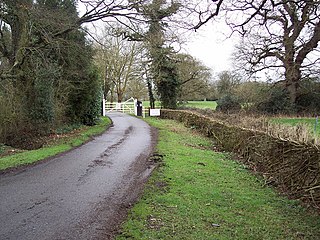
Clarendon Park is a Grade I listed building, estate and civil parish near Salisbury in Wiltshire, England. At the 2011 census the population of the parish was 246.
James Felton Somers Hervey-Bathurst is a British businessman and landowner.

Romanesque Revival, Norman Revival or Neo-Norman styles of building in the United Kingdom were inspired by the Romanesque architecture of the 11th and 12th centuries AD.
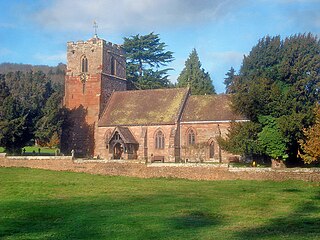
The Church of St John the Baptist is a Church of England parish church at Eastnor in the English county of Herefordshire. Of 12th century origins, the church was completely rebuilt between 1851 and 1852 by George Gilbert Scott for John Somers-Cocks, 2nd Earl Somers. It is a Grade I listed building.

